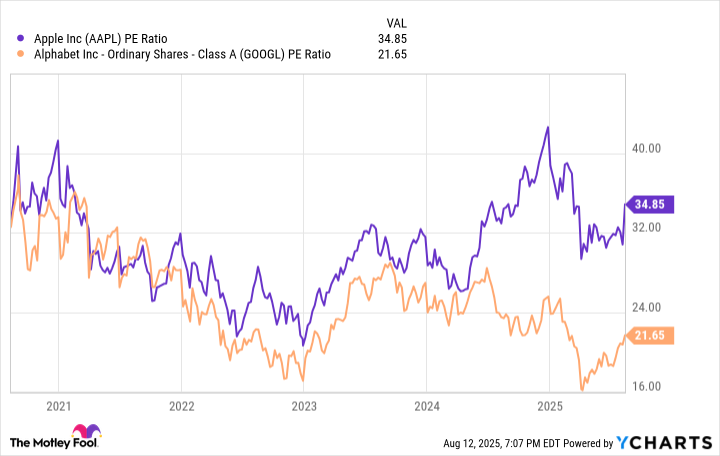Investors are back on the Apple (AAPL 0.06%) train. The stock of the multinational technology giant is still down slightly in 2025 but popped over 10% in the last week after management announced new planned spending in the U.S. CEO Tim Cook even visited the White House in a joint press conference with President Donald Trump to announce this new planned spending on components for the iPhone as well as other Apple products in America. It has helped the company achieve some breathing room around potential tariffs on semiconductors, iPhone components, and iPhones themselves getting imported to America.
Apple's stock got its mojo back on this upsized spending news, but should you actually buy shares today? Here's what the numbers say.

NASDAQ: AAPL
Key Data Points
A $600 billion investment
Earlier this year, Apple announced that it would spend $500 billion over the next four years in the United States. Last week, it upped its estimate to $600 billion, or $150 billion annually. This is different than a company's announced capital expenditure plans, such as when Amazon promises $100 billion in investments related to data centers and its delivery network. Apple is spending money with its suppliers, including advanced glass screens and various semiconductor manufacturers. It is more of an announcement around committed orders for products, which will spur demand for factory work in the United States.
Apple is a sprawling company, and the announced spending will occur in all 50 states, impact 450,000 jobs, and involve 79 different factories. It is astounding how complex Apple's supply chain for the iPhone and other computing hardware is today. However, Apple is still not at the point of a "Made in America iPhone" as assembly and other services are performed in China and India, with Apple negotiating with the U.S. government around what is feasible to bring to the United States.
Investors applauded the spending plans as a way to shy away from tariff risks on iPhone and semiconductor imports, which could have added huge costs to Apple's supply chain, damaging its profits. Now, it seems to be in good standing with the U.S. government and regulation authorities again.

Image source: Getty Images.
Does the announcement matter?
In regard to tariffs, this spending announcement won't necessarily hurt the company, it just prevents Apple from having future cost increases across its supply chain. However, since the U.S. has higher salaries and labor standards, this investment may lead to higher input costs for product components, which could lead to margin compression. Apple's operating margin has steadily risen since the COVID-19 pandemic, hitting a record high of 32% over the last 12 months. Sourcing components in the United States may reverse this expansion.
What matters more at the end of the day is demand for Apple's products. Last quarter, the company released solid figures for the three months ending in June. Total revenue grew just under 10% year over year, driven by services revenue and iPhone revenue growth. Even though the iPhone is almost 20 years old, it remains the bread and butter of Apple's business today.
This puts the company in a tough spot. Even though the iPhone remains wildly popular, unit volumes have stagnated for years, meaning Apple is only able to grow revenue by increasing prices. This is not an ideal position to be in. Price increases may be necessary just to maintain profit margins in the future if input costs grow due to the Made-in-America investments.
All in all, this announcement does matter. It just might be a negative for Apple's business, contrary to the stock's initial reaction.
AAPL PE Ratio data by YCharts
The truth about Apple stock
There are a lot of arguments to be made -- both bearish and bullish -- for Apple stock. Bulls might say this is a fantastic brand with major lock-in effects along with a growing services division with strong profit margins. Bears may say that Apple's unit volumes for the iPhone have fallen with no new successful products coming down the pipeline. For example, the Apple Vision Pro has turned into a total product bust, likely losing the company billions if not tens of billions of dollars.
A deciding factor in this debate could be the stock's valuation. Apple's price-to-earnings ratio (P/E) is 35. This is quite expensive for a business with low revenue growth. Compare that to Alphabet, which has grown its revenue significantly faster than Apple over the last few years but trades at a more reasonable P/E ratio of 22. Apple may be a great business, but that doesn't mean you should ignore the price you pay when analyzing its stock. Avoid buying shares of Apple after this post-announcement pop.









